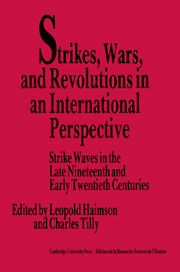 Strikes, Wars, and Revolutions in an International Perspective
Strikes, Wars, and Revolutions in an International Perspective Book contents
- Frontmatter
- Contents
- List of contributors
- Preface
- Part I Introductions
- Part II Models and realities
- 3 Introduction
- 4 Changing forms of labor conflict: secular development or strike waves?
- 5 Strikes and power in Britain, 1870–1920
- 6 Two strike waves in Imperial Russia, 1905–1907, 1912–1914
- 7 Strikers in revolution: Russia, 1917
- 8 Strikes in Imperial Russia, 1895–1913: a quantitative analysis
- 9 Labor conflicts in Italy before the rise of fascism, 1881–1923: a quantitative analysis
- 10 Strikes and politics in the United States, 1900–1919
- Part III Workers in metal-processing enterprises in comparative perspective
- Part IV The effects of short-term variation
- Part V Conclusion
5 - Strikes and power in Britain, 1870–1920
Published online by Cambridge University Press: 25 March 2010
- Frontmatter
- Contents
- List of contributors
- Preface
- Part I Introductions
- Part II Models and realities
- 3 Introduction
- 4 Changing forms of labor conflict: secular development or strike waves?
- 5 Strikes and power in Britain, 1870–1920
- 6 Two strike waves in Imperial Russia, 1905–1907, 1912–1914
- 7 Strikers in revolution: Russia, 1917
- 8 Strikes in Imperial Russia, 1895–1913: a quantitative analysis
- 9 Labor conflicts in Italy before the rise of fascism, 1881–1923: a quantitative analysis
- 10 Strikes and politics in the United States, 1900–1919
- Part III Workers in metal-processing enterprises in comparative perspective
- Part IV The effects of short-term variation
- Part V Conclusion
Summary
Not long ago, sociologists and labor economists used to talk confidently about the “natural history of the strike.” By that they meant its rather smooth progress along a line that supposedly rose rapidly in the early stages of industrial growth, gradually flattened out with the establishment of stable collective bargaining, and slowly fell as the strike proceeded to “wither away” in the prosperity of “advanced industrial society.”
Such notions have much less currency today. Striking has not died out; industrial conflict continues at high levels and periodically erupts into massive confrontations. Newer scholarship, informed by different concerns and predilections, has little sympathy with the earlier work, and has moved in quite different directions. The historical analysis of strikes has been thoroughly transformed, and bears little resemblance to the older studies. The emphasis now is upon complexity and variation, and teleological concepts about longterm trends have been replaced by a much finer sense of the contingent nature of strikes and labor movements within regions or industries. The strike is coming to be understood in terms of specific social contexts and as a manifestation of relations between workers, employers and, in many instances, the state rather than as some unproblematic reflection of working-class interests and grievances.
No doubt the sum of this new work is a major advance in the understanding of strikes and of labor history more broadly. But it does seem that something has been lost in the excessively local orientation of research, and in the decomposition and disaggregation of overall strike indices.
- Type
- Chapter
- Information
- Strikes, Wars, and Revolutions in an International PerspectiveStrike Waves in the Late Nineteenth and Early Twentieth Centuries, pp. 79 - 100Publisher: Cambridge University PressPrint publication year: 1989
- 2
- Cited by


